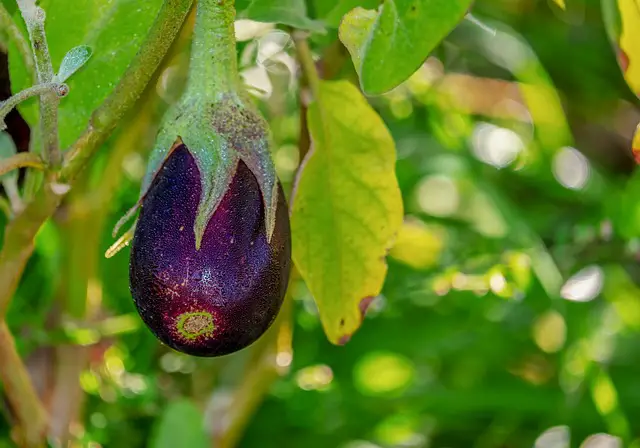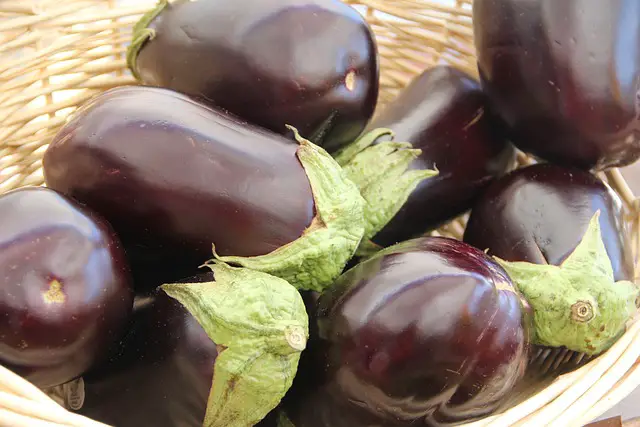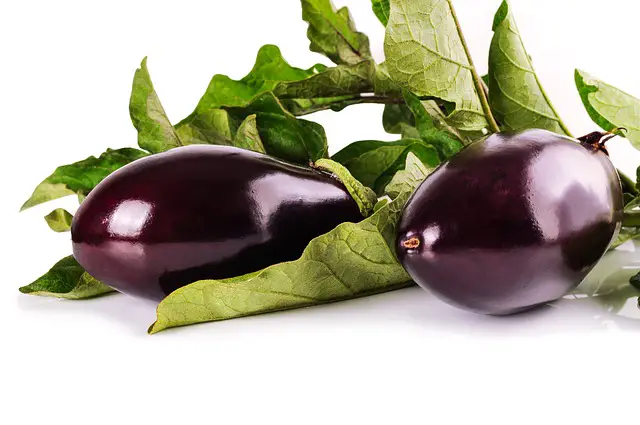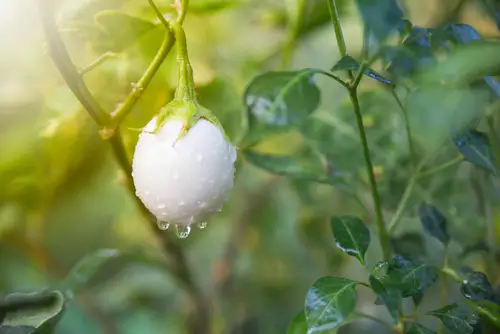White eggplants are a unique and delicate vegetable that can be a great addition to any garden. However, it can be concerning when the white eggplants start turning yellow. There are several reasons why this may happen, and it is important to understand the causes to prevent it from happening in the future.
One of the most common reasons for white eggplants turning yellow is overripe fruit. When the eggplant is allowed to grow too long, the flesh becomes mushy and the flavor becomes bitter.
It is important to know when to pick young eggplants to avoid this problem. Additionally, pest infestations can cause yellowing of leaves and skin, which can lead to sunburn on the fruits. Understanding the causes of yellowing can help gardeners take the necessary steps to prevent it from happening in the future.
Key Takeaways on White Eggplant Turning Yellow
- Overripe fruit is a common cause of white eggplants turning yellow.
- Pest infestations can lead to yellowing of leaves and skin.
- Knowing when to pick young eggplants and protecting them from pests can prevent white eggplants from turning yellow.
Also don’t miss:
- Why Are My Rhubarb Leaves Turning Yellow?
- Why Are My Prayer Plant Leaves Turning Yellow?
- Why Are My Soybeans Turning Yellow?
Understanding Eggplant Varieties

Eggplants are a versatile vegetable that come in a variety of shapes, sizes, and colors. The most common eggplant varieties are purple, but there are also white and green varieties available.
White eggplants, also known as ivory eggplants, are a unique variety that have a creamy, mild flavor and a tender texture. They are slightly sweeter than traditional purple eggplants and have a thinner skin.
Purple eggplants, on the other hand, are the most common variety of eggplant. They have a deep purple color and a slightly bitter taste. They are often used in Mediterranean and Middle Eastern cuisine.
Green eggplants, also known as Thai eggplants, are a smaller variety with a green skin and white flesh. They have a slightly bitter taste and are often used in curries and stir-fries.
When it comes to choosing an eggplant variety, it’s important to consider the dish you are making. For example, if you are making a dish that requires a sweeter flavor, white eggplants may be a better choice than purple eggplants.
In addition to color and flavor, eggplant varieties can also vary in size and shape. Some eggplants are round, while others are oblong or even pear-shaped. It’s important to choose an eggplant that is firm and heavy for its size, with smooth, shiny skin.
White Eggplant Turning Yellow
Eggplants are a popular vegetable in many parts of the world, known for their unique flavor and versatility in cooking. However, sometimes they can start to turn yellow, which can be a cause for concern. In this section, we will discuss some of the reasons why eggplants turn yellow.
1. Overripe Eggplants
One of the most common reasons for eggplants turning yellow is that they have become overripe. When eggplants are left on the vine for too long, they will start to turn yellow and become mushy.
This can also result in a bitter flavor that is not desirable in cooking. To avoid this, it is important to harvest eggplants when they are still young and firm.
2. Sun Exposure
Another reason why eggplants may turn yellow is due to sun exposure. When eggplants are exposed to too much direct sunlight, they can suffer from sunburn, which can cause premature yellowing.
This is especially common in white eggplants, which have a thinner skin than other varieties. To prevent this, it is important to provide shade or cover for eggplants during the hottest parts of the day.
3. Nutrient Deficiencies
Eggplants that are not receiving enough nutrients can also start to turn yellow. This is especially true for nitrogen, which is essential for healthy plant growth. If the soil is lacking in nitrogen, eggplants may start to show signs of yellowing.
To remedy this, it is important to ensure that the soil is properly fertilized and that the plants are receiving enough water.
4. Pests and Diseases

Finally, yellowing of eggplants may also be a sign of pests or diseases. Pests like spider mites can cause damage to the leaves and result in yellowing and defoliation of the plant.
Diseases like verticillium wilt and fusarium wilt can also cause yellowing of leaves and stems. It is important to regularly inspect eggplants for signs of pests or diseases and take appropriate measures to control them.
Significance of Soil and Weather
The soil and weather conditions play a crucial role in the growth and development of white eggplants. The proper balance of nutrients in the soil and the right weather conditions are essential for healthy plant growth and yield.
Soil
White eggplants require well-draining soil that is rich in organic matter. A soil test can help determine the pH level and nutrient content of the soil. The ideal pH range for eggplants is between 5.5 and 6.5. If the soil is too acidic or alkaline, it can affect the plant’s ability to absorb nutrients, leading to stunted growth and poor yield.
Weather
White eggplants grow best in warm weather with temperatures between 70°F and 85°F. They are sensitive to frost and cannot tolerate temperatures below 50°F. In hot weather, eggplants may experience sunscald, which can cause the fruit to turn yellow or brown.
Sunlight
White eggplants require full sun to grow and produce fruit. Direct sunlight is essential for the plant to photosynthesize and produce energy. However, in hot weather, the plant may require some shade to prevent sunscald. Shade cloth can be used to provide partial shade and protect the plant from direct sunlight.
Climate
White eggplants are best grown in a Mediterranean climate with long, hot summers and mild winters. They can be grown in other climates, but the yield may be lower. In colder climates, eggplants can be grown in a greenhouse or indoors.
Role of Proper Care and Watering

White eggplants need proper care and watering to grow healthy and produce high-quality fruits. Proper care involves providing the right growing conditions, including adequate moisture, good drainage, and regular fertilization.
One of the most critical factors in growing healthy white eggplants is watering. These plants require consistent moisture to thrive, but overwatering or underwatering can cause issues. Overwatering can lead to root rot, while underwatering can result in dry, wilted plants. Therefore, it is important to water the plants regularly, but not too much.
Proper care also involves monitoring the soil moisture and drainage. White eggplants require well-draining soil to prevent waterlogging, which can lead to root rot. A good drainage system helps to ensure that water does not accumulate around the roots, which can cause the plant to wilt and die.
In addition to proper watering and drainage, white eggplants also need regular fertilization to thrive. Fertilizers provide essential nutrients that the plant needs to grow and produce high-quality fruits.
However, over-fertilization can cause issues, including burning the plant’s roots. Therefore, it is essential to follow the recommended fertilization schedule and use the right type of fertilizer for the plant.
Proper care also involves monitoring for pests and diseases. White eggplants are susceptible to various pests and diseases, including aphids, spider mites, and fungal infections. Regular inspection of the plant can help detect any issues early, allowing for prompt treatment.
Importance of Fertilizers
Fertilizers play a crucial role in the growth and development of plants, including white eggplants. They provide essential nutrients that are necessary for the plants to thrive. Among these nutrients, nitrogen and potassium are particularly important for eggplants.
Nitrogen is a key component of chlorophyll, which is essential for photosynthesis. Without sufficient nitrogen, the leaves of the eggplant may turn yellow, and the plant may become stunted.
A lack of nitrogen can also cause the fruit to mature too quickly, resulting in poor quality and taste. A balanced fertilizer that contains nitrogen can help prevent nitrogen deficiency and ensure healthy plant growth.
Potassium is another important nutrient that eggplants require. It helps regulate water balance in the plant and is essential for the development of strong stems and roots.
A lack of potassium can cause the leaves to curl and become discolored, and the plant may produce fewer fruits. Applying a fertilizer that contains potassium can help prevent these issues and ensure healthy plant growth.
It is important to note that over-fertilization can also be harmful to the plant. Excessive nitrogen can lead to an overgrowth of leaves at the expense of fruit production, while too much potassium can interfere with the absorption of other nutrients.
It is important to follow the recommended application rates for fertilizers and to monitor the plant’s growth and development to ensure that it is receiving the nutrients it needs.
Pests and Diseases Affecting Eggplants

Eggplants are susceptible to a variety of pests and diseases that can cause yellowing of the leaves and skin. Some of the most common pests that invade eggplant bushes include flea beetles, aphids, and spider mites.
1. Flea Beetles
These small, jumping insects can cause significant damage to eggplant seedlings and foliage on mature plants. They create shot-hole feeding damage on eggplant foliage, which can cause yellowing of the leaves. Flea beetles can be controlled by using insecticidal soap or neem oil.
2. Aphids
These small, soft-bodied insects feed on the sap of eggplant plants and can cause yellowing of the leaves. They are often found on the undersides of the leaves, and their feeding can cause curling or distortion of the leaves. Aphids can be controlled by using insecticidal soap or neem oil.
3. Spider Mites
These tiny pests are difficult to see with the naked eye, but their feeding can cause yellowing of the leaves. They feed on the undersides of the leaves and can cause webbing to appear on the plant. Spider mites can be controlled by using insecticidal soap or neem oil.
Eggplants are also susceptible to a variety of diseases that can cause yellowing of the leaves and skin.
4. Early Blight
This fungal disease causes yellowing of the leaves, which then turn brown and fall off. The fruit may also develop sunken spots with concentric rings. Early blight can be controlled by using fungicides or by removing infected plant parts.
5. Verticillium Wilt
This fungal disease causes yellowing of the leaves, which then wilt and die. The fruit may also develop sunken spots with concentric rings. Verticillium wilt can be controlled by using fungicides or by removing infected plant parts.
Recognizing Overripe and Ripe Eggplants
White eggplants can turn yellow due to various reasons, including overripeness. It is essential to recognize when an eggplant is ripe and at the peak of its ripeness to avoid it turning yellow.
A ripe eggplant is firm and has a glossy skin. The skin should be taut and smooth, without any wrinkles or blemishes. When pressed gently, the skin should bounce back without leaving an indentation. The stem should be green and fresh-looking, without any signs of drying or wilting.
On the other hand, an overripe eggplant will have a dull, matte skin with wrinkles and blemishes. The skin will be soft to the touch, and when pressed, it will leave an indentation. The stem will be dry and brown, indicating that the eggplant is past its prime.
It is crucial to pick eggplants at the peak of their ripeness to avoid them turning yellow. Young, white eggplants turn white or cream-colored and have glossy, firm skin.
This is the best time to pick them because they haven’t reached full maturity, which results in a bitter flavor and spongy texture. When picking young eggplants, choose the ones with firm skin that leaves a slight indent when pressed with your finger.
It is also important to note that eggplants will continue to ripen after being picked. Therefore, it is best to use them as soon as possible after harvesting to avoid overripeness. If you are not planning on using them immediately, store them in the refrigerator to slow down the ripening process.
Harvesting and Storing Eggplants

Harvesting eggplants at the right time is crucial to get the best quality fruits. Eggplants should be harvested when they are firm, glossy, and have reached their mature size. If left on the plant for too long, they may turn yellow and become overripe, which can result in mushy flesh and bitter flavor.
When picking eggplants, it is important to use a sharp knife or pruning shears to avoid damaging the plant. The fruits should be cut from the plant with a small portion of the stem attached. This helps to prevent the fruits from drying out and reduces the risk of infection.
After harvesting, eggplants should be stored properly to maintain their quality and freshness. They should be kept in a cool, dry place away from direct sunlight. A temperature range of 50-55°F (10-13°C) is ideal for eggplant storage.
Eggplants are sensitive to ethylene gas, which is produced naturally by many fruits and vegetables as they ripen. Exposure to ethylene gas can cause eggplants to become overripe and turn yellow. Therefore, it is important to store eggplants away from ethylene-producing fruits such as apples, bananas, and tomatoes.
Eggplants can be stored for up to two weeks if kept in optimal conditions. However, it is best to use them as soon as possible for the best flavor and texture. If the eggplants start to wrinkle or become soft, they are no longer fresh and should be discarded.
Cooking and Serving Eggplants
Eggplants are a versatile vegetable that can be cooked in a variety of ways. The taste of eggplant is mild and slightly sweet, making it a perfect addition to many dishes. However, if not cooked properly, eggplants can have a bitter flavor that is not pleasant.
One of the most popular ways to cook eggplants is by frying them. Frying eggplants gives them a crispy texture and a delicious flavor. To fry eggplants, slice them into rounds or wedges and dip them in a batter made of flour and egg. Then, fry them in hot oil until they are golden brown.
Baking is another great way to cook eggplants. Baked eggplants have a soft and creamy texture and a mild flavor. To bake eggplants, slice them into rounds or wedges and brush them with olive oil. Then, bake them in the oven until they are tender and golden brown.
Sautéing is a quick and easy way to cook eggplants. Sautéed eggplants have a soft texture and a mild flavor. To sauté eggplants, slice them into rounds or cubes and cook them in a pan with olive oil until they are tender and lightly browned.
Grilling is another great way to cook eggplants. Grilled eggplants have a smoky flavor and a tender texture. To grill eggplants, slice them into rounds or wedges and brush them with olive oil. Then, grill them over high heat until they are tender and lightly charred.
When serving eggplants, they can be used in a variety of dishes, such as stir-fries, curries, and salads. They can also be served as a side dish or appetizer. To enhance the flavor of eggplants, they can be seasoned with herbs and spices, such as garlic, basil, and cumin.
Additional Tips for Growing Eggplants

Growing eggplants can be a rewarding experience, but it can also be challenging. Here are some additional tips to help ensure that your eggplant plants stay healthy and produce plenty of firm, glossy fruits.
1. Provide Adequate Air Circulation
Eggplants are susceptible to fungal diseases, so it’s crucial to provide adequate air circulation around the plants. This can be achieved by spacing the plants at least 18 to 24 inches apart. Pruning the eggplants can also help improve air circulation and reduce the risk of fungal diseases.
2. Keep the Soil Moist
Eggplants require consistent moisture to produce healthy foliage and fruits. The soil should be kept moist but not waterlogged. Containers can dry out quickly, so it’s essential to water them frequently, ideally in the morning.
3. Fertilize Regularly
Eggplants are heavy feeders, and they require regular fertilization to produce healthy foliage and fruits. A balanced fertilizer with micronutrients can help ensure that the plants have all the nutrients they need to thrive.
4. Monitor for Pests and Diseases
Eggplants are susceptible to a range of pests and diseases, including flea beetles, aphids, and fungal diseases. Regularly inspect the plants for any signs of infestation or disease and take appropriate action if necessary.
Organic insecticidal soap can help control pests, while pruning and providing adequate air circulation can help prevent fungal diseases.
5. Harvest at the Right Time
Eggplants should be harvested when they are firm and glossy. Overripe eggplants can turn yellow and become mushy, while underripe eggplants can be bitter. It’s essential to harvest the fruits at the right time to ensure that they have the best flavor and texture.
Frequently Asked Questions

Can you eat eggplant that has turned yellow?
Yes, as long as the eggplant is still firm and has not spoiled, it is safe to eat regardless of its color. When you cut open a white eggplant that has turned yellow, the flesh should still be firm and white with small, soft seeds. If the flesh is mushy or discolored, it is best to discard the eggplant as it may be spoiled.
Why are my eggplants turning green?
Eggplants are supposed to be green when they are young, and they turn yellow or white as they mature. If your eggplants are turning green, it could be a sign that they are not getting enough sunlight or that they are not getting enough nutrients from the soil.
Try moving your eggplants to a sunnier location or fertilizing them with a balanced fertilizer.
Why is my eggplant losing color?
Eggplants can lose their color for several reasons. One of the main causes of white eggplant turning yellow is allowing it to grow too long. Overripe eggplant results in mushy flesh and bitter flavor.
Pests invading your eggplant bushes cause yellowing of leaves and skin. Yellowing of leaves is often caused by care problems like irregular watering or a lack of nitrogen in the soil.
Why is my white eggplant not growing?
If your white eggplant is not growing, it could be due to a lack of nutrients in the soil or a pest infestation. Make sure that your eggplant is planted in well-draining soil that is rich in organic matter. Fertilize your eggplant with a balanced fertilizer and keep an eye out for pests like aphids, spider mites, and flea beetles.
What are some benefits of yellow eggplant?
Yellow eggplant is a good source of dietary fiber, potassium, and vitamin C. It is also low in calories and fat, making it a great addition to a healthy diet. Some studies suggest that eggplant may have anti-inflammatory and antioxidant properties.
What are some varieties of yellow eggplant?
There are several varieties of yellow eggplant, including the Thai Yellow Eggplant, the Yellow Bell Eggplant, and the Long Yellow Eggplant. Each variety has a slightly different flavor and texture, so it’s worth experimenting with different types to find the one that you like best.

Hey, I’m Lisa and I’ve been an avid gardener for over 30 years. I love writing, talking and living in the garden! Feel free to connect with me on my socials below

